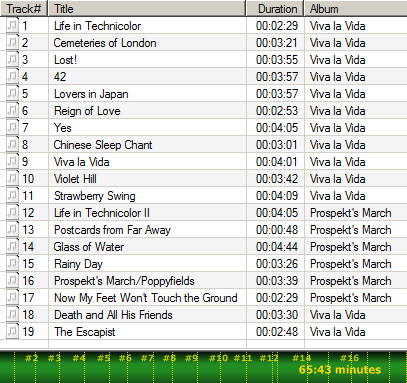How To Fit Coldplay’s Vida La Vida & Prospekt’s March On One CD
September 11, 2013 Leave a Comment

Since Coldplay has a new song and music video out this week (“Atlas” from the Catching Fire soundtrack), I figured this post was finally vaguely relevant. It’s a problem affecting an extremely limited number of people, I realize, but just in case you:
- own both Viva la Vida and Prospekt’s March, the 2008 LP and EP from Coldplay;
- feel the need to listen to both of them together without repetition;
- still use compact discs; and
- have not solved this problem for yourself in the five years you’ve had to do so;
I am here to help.
The screenshot below shows a track listing in the program CDBurnerXP. Tracks 5 and 6 were separated using Audacity, as were tracks 7 and 8 as well as 18 and 19. Doing so is optional, but it bugs me when songs do not perfectly correlate to tracks. (I left 16 as it was because there’s no point of silence to split the track, and “Poppyfields” is pretty much only 30 seconds of synthy woo-woo sounds anyhow.)
You might notice that two tracks from Prospekt’s March are entirely missing; this is ostensibly because the full runtime of all the songs on both collections adds up to 74:04, and standard audio CDs don’t go past 74 minutes flat. However, the missing tracks are just a virtually identical remix of “Lovers in Japan” and a terrible, terrible version of “Lost!” featuring one Jay-Z. Seriously guys, the “feat. [some rapper]” addendum is never a good idea. And although increasing the tempo of “Lovers in Japan” by approximately one beat per minute for the “Osaka Sun Remix” gives it an utterly different sound, I’m not sure I can bear the transcendence of lines like “Soldiers, you’ve got to soldier on” more than once in 66 minutes.
I wish I could share an ISO of the disc with convenient, cutting-edge features like CD-TEXT tagging, but you know, that would be illegal. This Grooveshark playlist should be slightly less so.
Thanks to Everywhere Art for demarcating the areas of Eugene Delacroix paintings used on the album covers in question.









